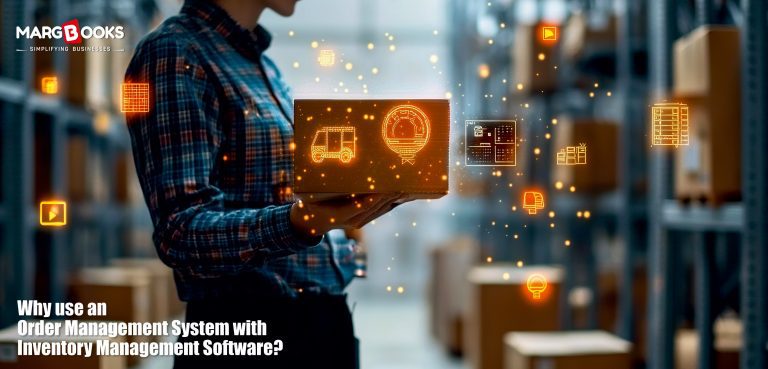Whether you’re running a small trading company or a growing e-commerce venture, streamlining operations is key to staying ahead of the competition. One of the most effective ways to do this is by integrating an Order Management System with your Inventory Management Software.
You might be wondering-why do I need both? Isn’t one enough? The truth is, while each of these systems works well on its own, combining them brings out the best of both worlds. Let’s dig deeper into why this integration is a game-changer for businesses across industries.
What is an Order Management System?
An Order Management System (OMS) is a digital solution that helps businesses track sales, orders, inventory, and fulfilment. It enables seamless coordination between your sales team, warehouse, and accounting department, ensuring every order is processed accurately and on time.
With features like order tracking, invoicing, shipping coordination, and return handling, an OMS takes the guesswork out of managing orders manually. It’s like having a personal assistant who never misses a beat.
What is Inventory Management Software?
On the other hand, Inventory Management Software focuses on tracking stock levels, managing reorders, and optimising warehouse space. It provides a bird’s-eye view of all your inventory, what’s in stock, what’s running low, and what’s gathering dust on the shelves.
Modern online inventory management software, like MargBooks, takes this a step further by offering real-time insights, cloud access, and multi-location tracking, making it ideal for businesses that operate in today’s digital-first environment.
Why Should You Combine Them?
Now that we’ve looked at each system separately, here’s why combining your Order Management System with your Inventory Management Software is a smart business move:
1. Real-Time Inventory Updates
Every time an order is placed, your inventory levels are affected. With integration, as soon as an order is confirmed, the stock count automatically adjusts. This reduces the risk of overselling and ensures you never disappoint a customer with an “Out of Stock” message after payment is made.
2. Faster Order Processing
Manual data entry can lead to delays and errors. An integrated system reduces repetitive tasks, such as re-entering product details or customer information, and accelerates the order fulfilment process.
3. Better Customer Experience
Customers today expect quick and accurate service. When your order and inventory systems work hand-in-hand, you can fulfil orders faster, update customers promptly, and handle returns or exchanges smoothly—all of which improve customer satisfaction.
4. Improved Decision-Making
With everything in one place—sales data, stock levels, order history—you gain valuable insights into what’s working and what’s not. This helps you make smarter purchasing and sales decisions, forecast demand, and manage slow-moving stock.
5. Minimised Stock Issues
Whether it’s understocking or overstocking, both scenarios hurt business. Integration ensures that you get alerts when stocks run low and helps you plan replenishments just in time—saving money and warehouse space.
6. Increased Team Collaboration
When different departments like sales, warehousing, and accounting access a unified system, there’s better coordination and fewer chances of miscommunication. Everyone stays on the same page.
Role of Online Solutions: Why Cloud Matters
It’s relying on offline systems can hold you back. That’s why online inventory management software solutions like MargBooks are making waves.
With MargBooks, you can:
- Access data anytime, anywhere
- Sync your sales and inventory in real-time
- Manage multiple warehouses from one dashboard
- Automate order processing and stock updates
- Get detailed reports for better business planning
Cloud-based tools are especially helpful for businesses that operate across multiple locations or want to scale quickly without the headache of server maintenance and manual updates.
Why Choose MargBooks?
When it comes to reliable and easy-to-use software, MargBooks stands out for Indian businesses. It offers an all-in-one platform that integrates Order Management System and Inventory Management Software seamlessly. Whether you’re managing retail, wholesale, distribution, or manufacturing operations, MargBooks can be tailored to suit your workflow.
Key Benefits of MargBooks:
- GST-compliant billing and invoicing
- Barcode-enabled stock tracking
- Purchase and sales order management
- Real-time inventory visibility
- Simple user interface, even for non-tech users
MargBooks is built keeping Indian businesses in mind, offering both English and regional language support. It’s ideal for entrepreneurs who want to go digital without a steep learning curve.
Final Thoughts
Integrating your Order Management System with Inventory Management Software is no longer a luxury. It’s a necessity for efficient operations, happy customers, and sustainable growth. In a competitive market like India, where customer expectations are sky-high and margins are tight, leveraging the right technology can make all the difference.
So, if you’re looking to simplify your business operations, reduce errors, and grow smarter. It’s time to switch to a comprehensive solution like MargBooks, where order and inventory management come together effortlessly.




